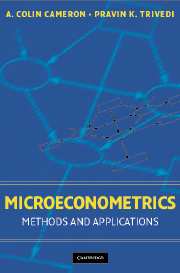 A. Colin Cameron and Pravin
K. Trivedi
A. Colin Cameron and Pravin
K. Trivedi
MICROECONOMETRICS: Methods and Applications
Cambridge University Press, New York
May 2005
PART 5 (chapters 21-23)
Cross section models have certain inherent limitations. They are predominantly
equilibrium models that generally do not shed light on intertemporal dependence
of events. They also cannot satisfactorily resolve fundamental issues about
the sources of persistence in behavior. Such persistence may be behavioral,
i.e. arising from true state dependence, or it may be spurious, being an
artifact of the inability to control for heterogeneous behavior in the population.
Because panel data, also called longitudinal data, contain periodically repeated
observations of the same subjects, they have a large potential for resolving
issues that cross section models cannot satisfactorily handle. Chapters 21
through 23 present methods for panel data. We progress systematically from
linear models for continuous data in Chapter 21 to nonlinear panel data models
for limited dependent variables in Chapter 23. Both fixed effects and random
effects models are considered. A persistent theme through these three chapters
is the importance of using robust methods of inference.
Chapter 21, which reviews the key general results for linear panel data regression
models, can be read easily by those with a good grasp of linear regression;
it does not require the material covered in Parts 2 to 4. We recommend that
even those who are interested in more advanced material should quickly peruse
through the contents of this chapter first to gain familiarity with key concepts
and definitions.
Chapter 22 covers important extensions of Chapter 21, especially to dynamic
panels which allow for Markovian dependence structure of current variables.
The analysis is in the GMM framework that is currently favored by many practitioners
in this area. The analysis here is at times intricate, involving many
issues of detail. A strong grasp of GMM will be helpful in absorbing the
main results of this chapter.
The results of Chapters 21 and 22 do not extend to nonlinear panel
models of Chapter 23 in a general and unified fashion. There are relatively
fewer general results for limited dependent variable panel models. Despite
this, in Chapter 23 we begin by presenting an analysis of some general issues
and approaches. Later sections can be treated as panel data extensions of
the counterpart cross section models in Part 4. these analyze four
categories of models for binary, count , censored, and duration
data, respectively. These should be accessible to a suitably prepared reader
familiar with the parallel cross section models.
Back to Main Page
 A. Colin Cameron and Pravin
K. Trivedi
A. Colin Cameron and Pravin
K. Trivedi